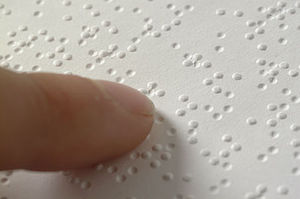Braille (/ˈbreɪl/ BRAYL; Braille: ⠃⠗⠇; French: [bʁaj]) is a tactile writing system used by people who are visually impaired. It is traditionally written with embossed paper. Braille users can read computer screens and other electronic supports using refreshable braille displays. They can write braille with the original slate and stylus or type it on a braille writer, such as a portable braille notetaker or computer that prints with a braille embosser. Braille is named after its creator, Louis Braille, a Frenchman who lost his sight as a result of a childhood accident. In 1824, at the age of fifteen, he developed a code for the French alphabet as an improvement on night writing. He published his system, which subsequently included musical notation, in 1829. The second revision, published in 1837, was the first binary form of writing developed in the modern era. These characters have rectangular blocks called cells that have tiny bumps called raised dots. The number and arrangement of these dots distinguish one character from another. Since the various braille alphabets originated as transcription codes for printed writing, the mappings (sets of character designations) vary from language to language, and even within one; in English Braille there are three levels of encoding: Grade 1 – a letter-by-letter transcription used for basic literacy; Grade 2 – an addition of abbreviations and contractions; and Grade 3 – various non-standardized personal stenography. Braille cells are not the only thing to appear in braille text. There may be embossed illustrations and graphs, with the lines either solid or made of series of dots, arrows, bullets that are larger than braille dots, etc. A full braille cell includes six raised dots arranged in two columns, each column having three dots. The dot positions are identified by numbers from one to six. There are 64 possible combinations, including no dots at all for a word space. A cell can be used to represent a letter, digit, punctuation mark, or even a word. Early braille education is crucial to literacy, education and employment among the blind. However, in the face of changes in education policy and screen reader software, braille usage has declined in recent decades, despite the fact that technologies such as braille displays have also made braille more accessible and practical.




Comment
0